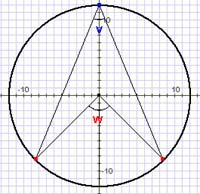4. Trigonometrie
Aus Online Mathematik Brückenkurs 1
| \displaystyle \text{@(a class="image" href="http://smaug.nti.se/temp/KTH/film5.html" target="_blank")@(img src="http://wiki.math.se/wikis/2008/forberedandematte1/img_auth.php/0/00/Lars_och_Elin.jpg" alt="Film om trigonometri")@(/img)@(/a)} |
How old are geometry and trigonometry and when did one start to use these methods to solve problems?
Watch the video in which the lecturer Lasse Svensson tells us how geometry and trigonometry developed and answers Elins questions.
Was ist Geometrie?
Geometrie ist eine alte Wissenschaft. Das Wort Geometrie stammt aus den Griechischen Wörtern "Ge" und "Metri", und heißt ungefähr "Landmessung".
Der vielleicht meist bekannte Mathematiker in der Geometrie, war Euklid. Er schrieb das berühmte Werk "Die Elemente", wo er die ganze Mathematik in seiner Zeit zusammenfasste. In den 17 Jahrhundert begann man an einige der Euklidischen Axiome zu bezweifeln. Daraus entstand die sogenannte nichteuklidische Geometrie.
Trigonometry comes from Greek ("trigonon" stands for "triangle" and "metron" stands for "measure") and is a method to calculate the angles and sides of right-angled triangles. Trigonometry developed a few hundred years before the birth of Christ. One of the most famous mathematicians was HIPPARCHUS, who worked with the circle and chords within a circle. For each chord, he was able to calculate the corresponding arc length and in this way, he was able to determine the sides and angles of triangles. All this took place 2200 years before the advent of the calculator!
In this chapter we will see some examples of how geometric objects such as lines, parabolas and circles are described by equations. Similarly various regions can be described by inequalities.
The unit circle is of particular importance
The circle with a radius of 1 around the origin is especially important. One can use this circle to introduce the various concepts regarding angles as well as the trigonometric functions cosine and sine.
An angle corresponds to a point on the unit circle, the measure of the angle is the distance along the circle to the point (1.0), the cosine of the angle is the "x"-component of the point, the sine of the angle is "y"-component of the point.
The functions cosine and sine thus are used to translate from angles to distances.
If one is accustomed to think of cosine and sine as relations between the sides of a right-angled triangle, it is extremely important to rethink these functions in terms of the unit circle. This way it will be easier to understand trigonometric relationships like periodicity and the Pythagorean identity, the relationships for doubling angles and the formulas for derivatives.
To be able to manage and manipulate trigonometric expressions is important in most applications of mathematics. Thus the final section provides a thorough exercise to practise these skills.
Once geometry was one of the main elements in a mathematics course. In recent decades, classical geometry has decreased both in high school as well as in university's courses. But, for anyone who intends to be active in photography or graphics or with construction and design (such as CAD), a good knowledge of geometry is very valuable.
A knowledge of geometry is also very useful in everyday life, where one is often faced with questions of a geometrical nature.
It is important to note that the material in this section— as well as in other parts of the course — is designed that one does not use calculators.
Um den Abschnitt Trigonometrie
- Lesen Sie zuerst den Theorieabschnitt und lesen Sie die Beispiele durch.
- Lösen Sie danach die Übungen ohne Taschenrechner. Kontrollieren Sie Ihre Antworten indem Sie auf "Antwort" klicken. Falls Sie Hilfe brauchen können Sie auf "Lösung" klicken um mit Ihrer Lösung zu vergleichen.
- Wenn Sie mit den Übungen fertig sind können Sie die diagnostische Prüfung für das aktuelle Kapitel machen.
- Falls Sie irgendwelche Schwierigkeiten haben, können Sie im Forum nach ähnlichen Beiträgen suchen. Wenn Sie keinen hilfreichen Beitrag finden, können Sie selber eine Frage im Forum stellen, die ein Mentor (oder anderer Student) innerhalb von ein paar Stunden beantworten wird.
- Wenn Sie die diagnostische Prüfung bestanden haben, sollten Sie die Schlussprüfung machen. Um die Schlussprüfung zu bestehen, müssen Sie drei aufeinanderfolgende Fragen richtig beantworten.
- Wenn Sie die diagnostische Prüfung und die Schlussprüfung geschafft haben, haben Sie das Kapitel bestanden, und können mit dem nächsten Kapitel beginnen.

